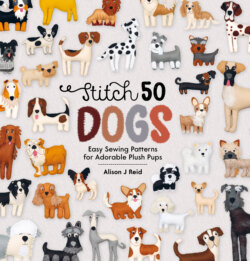Читать книгу Stitch 50 Dogs - Alison J Reid - Страница 7
ОглавлениеUsing The Design Guides
Each dog has its own unique templates and Design Guide. The Design Guide indicates which stitches to use, along with other construction and design features. Tips on using these guides are on the following pages.
Sewing the Dogs
1. The dogs are made using the templates at the size provided. To transfer the templates to your felt, begin by tracing them onto tracing paper. Label each template with its name, felt colour and quantity of pieces required, then cut them out.
To transfer each template to the felt, position it on the appropriate colour and secure with dressmaking pins. Use a white (or contrasting color) chalk pencil to draw around the edge, marking the felt. This will be your cutting line. Repeat as needed.
If the design asks you to needle-felt a shape before cutting it out, flip the relevant template back-to-front and mark the shape on the non-needle felted side of the felt before cutting. Small areas of needle felting can be done after cutting out.
2. Take one of your two main body pieces and build up the appropriate markings and features of your dog. Leave the ears aside for the moment. Refer to your dog's Design Guide and the key opposite to place the various features and smaller areas of needle felting. You can use a little fabric glue to secure smaller pieces in place as you stitch. Refer to the Stitch Library for guidance (A).
3. Add the eyes using brads (see Inserting Brads) (B).
4. Referring to the Design Guide and key again, place the ears of your chosen dog behind the head of the embroidered body piece (C).
5. Match the two body pieces, tuck the ears between the layers and secure with dressmaking pins. To join the layers, sew blanket stitch around the edge of the body and running stitch over the ears (see Stitch Library). Leave a gap as shown on the Design Guide.
6. Stuff with polyester toy filling for a 3D effect (see Stuff It!) (D).
7. Sew the gap(s) closed using blanket stitch.
STUFF IT!
Try rolling a pea-sized ball of stuffing between your fingers to make it easier to push into small, tight spaces.
Inserting Brads
Referring to the Design Guide, use the darning needle to make a hole in the felt for each eye. Push the tail of the brad through the hole – the head should lie flat to the surface of the felt (E). Press open the tail against the back of the felt (F).
Needle Felting
Needle felting creates textured fur. To begin, place the felt sheet that will form the base of the felting on top of the felting brush, right side up.
Tear off a small piece of wool roving, shaping it gently to cover your felt or create the shape shown on the Design Guide. Position it over the felt, and use the wool felting needles to poke the two fabrics together to bond them. Poke the needles in an up-and-down motion so that they pass easily in and out of the felt (G).
Perform this process on a flat surface away from your body. Keep fingers away from the moving needles.
KEY TO DESIGN GUIDES
